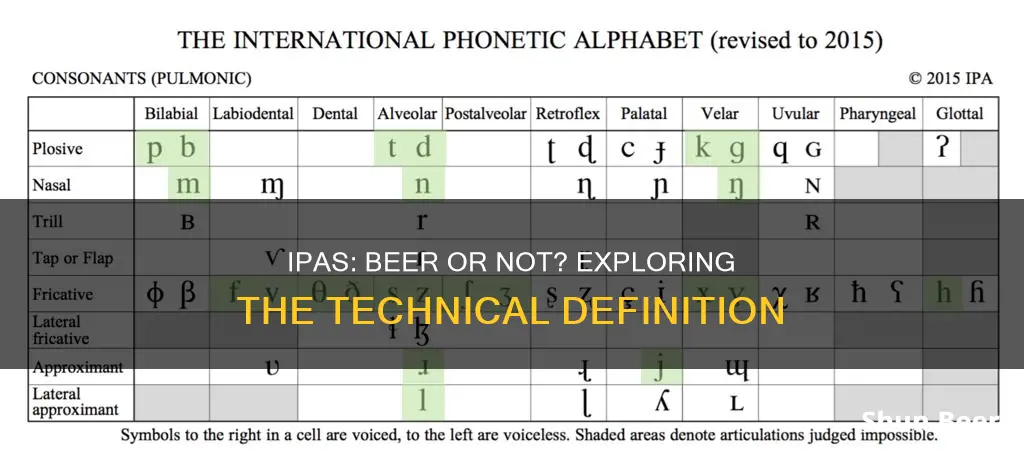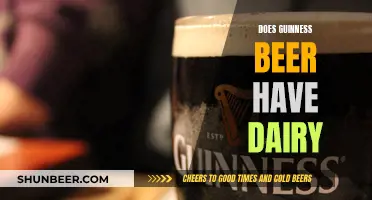
India Pale Ale, or IPA, is a style of beer that is popular enough to be called regular beer. It is a type of pale ale but is made with more hops, giving it a stronger flavour. IPAs are known for their hoppy and bitter taste, with citrus and fruit notes. They have a higher ABV than most other types of beer, typically ranging from 7% to 10%, although some session IPAs have a lower ABV of around 4% to 5%. The popularity of IPAs has led to a wide variety of styles, including English, West Coast, East Coast, Double or Imperial, and Triple IPAs, each with its distinct flavour profile and ABV.
| Characteristics | Values |
|---|---|
| Full Form | India Pale Ale or Indian Pale Ale |
| Origin | British sailors on six-month voyages to India |
| Reason for Origin | To withstand changing temperatures and last long journeys |
| Flavour | Hoppy, Fruity, Bitter, Malty, Piney, Citrusy, Herbaceous, Evergreen |
| Alcohol Content | 4-5% ABV (Session IPA), 6-7% ABV (Modern American IPA), 7% or more (Double/Imperial IPA), 10% or more (Triple IPA) |
| Carbonation | Lower than other beers (New England IPA) |
| Clarity | Hazy (New England IPA), Brilliant (American/West Coast IPA) |
| Malt Character | Minimal (American/West Coast IPA) |
| Bitterness | 40-60 IBU (International Bitterness Units), 40-70 IBU (American/West Coast IPA) |
What You'll Learn

What does IPA stand for?
IPA stands for Indian Pale Ale or India Pale Ale. The name has its roots in the British Empire and its colonies. During colonial times, sailors sought a beer recipe that would be easy to preserve on long trips from Britain to India. The weather in India was too hot and humid to brew good beer.
So, a beer with lots of hops was brewed to survive long journeys without spoiling. And from these humble origins, the India Pale Ale was born! The IPA has come a long way since colonial times, but the hoppy quality has mostly remained the same.
IPA is a style of pale ale that emphasizes hop flavours and aromas. It is a type of pale ale but is made with more hops, giving it a stronger flavour. There is no standardized threshold at which a pale ale becomes an IPA, though. It's up to the brewer.
The IPA was invented in Britain. British sailors, while sailing to India, loaded up barrels of beer with hops because hops were a preservative. The hops remained in the beer for so long that they lost their fruity flavour and left a bitter-tasting beer. So, British IPAs are malty, bitter, and one-noted. They aren't the most popular style today, but it's important to know one when you see one.
Guinness World Records: Beer, Books, and Branding
You may want to see also

How did IPAs become so popular?
India Pale Ale (IPA) is a hoppy beer style within the broader category of pale ales. The IPA was invented in Britain during the colonial era. British sailors needed a beer recipe that would be easy to preserve on long trips from Britain to India. The weather in India was too hot and humid to brew good beer. So, the sailors brewed a beer with lots of hops that could survive long journeys without spoiling. The hops hung around in the beer for so long that they lost their fruity flavour and left a bitter-tasting beer.
IPAs became popular in the 1990s when Sierra Nevada and Dogfishhead produced beers that were far hoppier than consumers were used to, and they were a hit. In the 2000s, 'everything' became an IPA. The style really took off in the 2010s with the emergence of hazy IPAs. In the 21st century, US-influenced IPA is one of the most popular beer styles in the UK. It is estimated that over 40% of craft beer brewed in the United States can be classified as an IPA.
The popularity of IPAs can be attributed to several factors. Firstly, the high preservative oil content in hops kept the brew fresh during export from England to British colonies in India in the 18th century. Secondly, the early IPAs were only slightly higher in alcohol content than other beers, but more of the wort was fermented, resulting in fewer residual sugars and a heavily hopped beer. This combination of factors made IPAs ideal for export and long-term storage.
Additionally, the emergence of craft brewing and microbreweries in the late 2000s and early 2010s contributed to the popularity of IPAs. Brewers began seeking out old beer styles that had fallen out of fashion, and the traditional IPA style was well-suited to showcase the intense flavour and aroma of American hops. The boom in popularity for IPA as a style spread down the west coast of the United States, then across the country and eventually the world.
The History of IPA Beer: A Bitter Origin Story
You may want to see also

What is the average ABV of an IPA?
India Pale Ale (IPA) is a hoppy beer style within the broader category of pale ales. The average ABV of an IPA is around 6.3% to 7.5%, but this can vary depending on the specific type of IPA and the brewer's preferences.
The IPA was originally developed in Britain during the colonial era as a beer that could withstand long voyages to India. Early IPAs were only slightly higher in alcohol content than other beers of the time, with an average ABV of around 5%. However, they were heavily hopped, which acted as a preservative and gave the beer a longer shelf life.
Today, there are several different types of IPAs, including:
- Session IPAs: These are lower in alcohol content, typically below 5% ABV, making them perfect for drinking multiple pints in one session.
- Double or Imperial IPAs: These have a higher alcohol content, typically over 7% ABV, and a more intense hop character.
- New England IPAs (NEIPAs): This style is characterised by a cloudy or hazy appearance, juicy, thicker flavours, and a smooth, pillowy mouthfeel.
- Triple IPAs: These have even higher alcohol content, usually over 10% ABV, and more prominent hop flavours.
While the average ABV of an IPA is around 6.3% to 7.5%, it's worth noting that individual beers can differ, and some IPAs may have a slightly lower or higher ABV depending on the specific recipe and brewing techniques used. Additionally, the ABV of an IPA can vary depending on the region and brewer, with some American IPAs, for example, tending to have a higher ABV than their British counterparts.
Football Stars in Guinness Beer Ads: Who's Featured?
You may want to see also

What do IPAs taste like?
IPAs are known for their strong taste, which is due to the fact that they contain more hops than other kinds of beer. The bitterness of an IPA is influenced by the types of hops used, and different varieties of hops create different flavours. For example, hops such as Citra, Mosaic, and Simcoe are added to IPAs to give them a citrus flavour, while Centennial and Chinook are used to create earthy flavours.
The flavour of an IPA also depends on the style. New England, West Coast, and English IPAs tend to have a more fruity flavour and are less bitter than other IPAs. English IPAs, in particular, are maltier and more bitter than New England IPAs.
In addition to the types of hops and the style, the bitterness of an IPA can be influenced by its freshness. Hops become less potent over time, so IPAs made with older hops tend to have less interesting flavours.
While IPAs are known for their bitterness, not all IPAs are overly bitter. For example, the Northeast-style IPA uses hops later in the brewing process, which intensifies fragrances and aromas rather than bitterness.
Overall, the flavour of an IPA can vary significantly depending on the types of hops used, the style, and the freshness of the beer.
Guinness: A Dark Porter Beer With a Rich History
You may want to see also

What is a double IPA?
A Double IPA, also known as an Imperial IPA, is a type of beer with a higher alcohol content and a more intense hoppy flavour than a regular IPA. The style was first brewed in California in the 1990s and has since become a popular choice among craft beer enthusiasts.
Double IPAs are brewed with more hops and malt than regular IPAs, resulting in a stronger brew with a more robust and varied flavour. The extra malt provides more sugar for the yeast to convert into alcohol, while the additional hops promote more bitterness and a distinct toasted or caramel malt flavour. The average IPA has an ABV of around 5-7%, while a Double IPA typically ranges from 7-10% ABV.
Double IPAs are typically pale in colour, ranging from golden to amber, and often have a hazy or cloudy appearance. They are known for their bold and unique character, with a strong bitterness and a complex, full-bodied flavour profile that blends sweet and bitter notes. The increased alcohol content can also add a malty sweetness to the beer, balancing out the bitterness of the hops.
Despite their intense flavour and high alcohol content, Double IPAs are often enjoyed by craft beer enthusiasts for their distinctive aroma and flavour. The style is particularly favoured by "hop-heads", who relish the strong bitterness and intense hoppy characteristics.
Guinness Beer: A Domestic or Foreign Affair?
You may want to see also
Frequently asked questions
IPA stands for Indian Pale Ale or India Pale Ale.
IPAs were first brewed in the UK in the 1780s. They became popular among British soldiers and sailors serving in India, as the beer could survive the long journey without spoiling.
IPA is a style of beer, characterised by a stronger flavour due to a higher concentration of hops.
There is no inherent difference in strength between IPAs and other beers. However, IPAs often have a higher ABV, which has contributed to their reputation for being strong.
There are many types of IPAs, including English, West Coast, East Coast, Session, Black, Belgian, and Double or Imperial IPAs.







